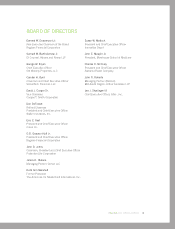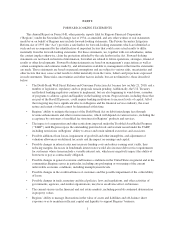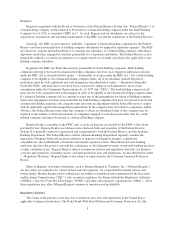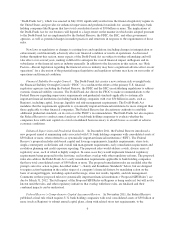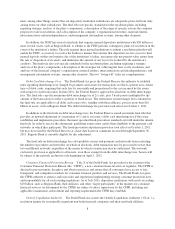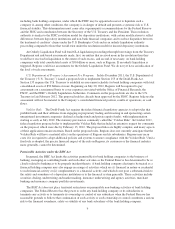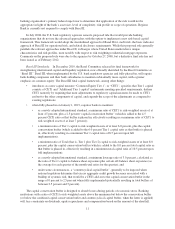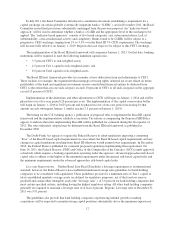Regions Bank 2011 Annual Report Download - page 31
Download and view the complete annual report
Please find page 31 of the 2011 Regions Bank annual report below. You can navigate through the pages in the report by either clicking on the pages listed below, or by using the keyword search tool below to find specific information within the annual report.appropriate Federal Reserve Bank for approval. The capital analysis and review process provided for in the rule
is known as the Comprehensive Capital Analysis and Review (“CCAR”). The purpose of the capital plan is to
ensure that these bank holding companies have robust, forward-looking capital planning processes that account
for each company’s unique risks and that permit continued operations during times of economic and financial
stress. The capital plans are required to be submitted on an annual basis. Such bank holding companies will also
be required to collect and report certain related data on a quarterly basis to allow the Federal Reserve to monitor
the companies’ progress against their annual capital plans. The comprehensive capital plans, which are prepared
using Basel I capital guidelines, include a view of capital adequacy under four scenarios – a bank holding
company-defined baseline scenario, a baseline scenario provided by the Federal Reserve, at least one bank
holding company-defined stress scenario and a stress scenario provided by the Federal Reserve. The rules
require, among other things, that a covered bank holding company may not make a capital distribution unless it
will meet all minimum regulatory capital ratios and have a ratio of Tier 1 common equity to risk-weighted assets
of at least 5% after making the distribution. The rules also provide that the Federal Reserve may object to a
capital plan if the plan does not show that the covered bank holding company will maintain a Tier 1 common
equity ratio of at least 5 percent on a pro forma basis under expected and stressful conditions throughout the
nine-quarter planning horizon covered by the capital plan. Covered bank holding companies, including Regions,
may pay dividends and repurchase stock only in accordance with a capital plan that has been reviewed and
approved by the Federal Reserve. The CCAR rule, consistent with prior Federal Reserve Board guidance,
provides that capital plans contemplating dividend payout ratios exceeding 30% of after-tax net income will
receive particularly close scrutiny.
As part of this process, Regions will also provide the Federal Reserve with projections covering the time
period it will take for Regions to fully comply with Basel III capital guidelines, including the 7% Tier 1 common
equity, 8.5% Tier 1 capital and 3% leverage ratios as well as granular components of those elements. Regions’
capital plan was submitted on January 9, 2012.
The Proposed SIFI Rules, discussed earlier in this section under “Enhanced Supervision and Prudential
Standards,” would expand the stress testing requirements to include, among other things, stress testing by the
Federal Reserve under three economic and financial scenarios, including adverse and severely adverse scenarios.
We would also be required to conduct our own semi-annual stress analysis (together with the Federal Reserve’s
stress analysis, the “Stress Tests”) to assess the potential impact on Regions, including our consolidated earnings,
losses and capital, under each of the economic and financial conditions used as part of the Federal Reserve’s
annual stress analysis. A summary of the results of certain aspects of the Federal Reserve’s stress analysis will be
released publicly and will contain bank holding company specific information and results. We would also be
required to disclose the results of our semi-annual stress analyses.
Proposed Joint Guidance on Stress Testing. In addition to the stress testing requirements under the
Proposed SIFI Rules, the federal banking agencies proposed joint guidance on stress testing on June 15, 2011.
Unlike the Proposed SIFI Rules, the proposed joint guidance addresses stress testing in connection with overall
risk management, and not just capital and liquidity stress testing. The June 2011 proposed guidance outlines
high-level principles for stress testing practices, applicable to all Federal Reserve-supervised banking
organizations with more than $10 billion in total consolidated assets, such as Regions. The proposed guidance
highlights the importance of stress testing as an ongoing risk management practice that supports a banking
organization’s forward-looking assessment of its risks. The agencies intend the proposed guidance to serve as a
background for future rulemaking activities and supervisory initiatives. Comments were due on July 29, 2011. As
of February 2012, no final rule has been adopted. The final rule is expected to be consistent with the stress testing
requirements set forth under the Dodd-Frank Act and the Proposed SIFI Rules.
Living Will Requirement. As required by the Dodd-Frank Act, the Federal Reserve and the FDIC have
jointly issued a final rule that requires certain organizations, including each bank holding company with
consolidated assets of $50 billion or more, to report periodically to regulators a plan (a so-called “living will”)
for their rapid and orderly resolution in the event of material financial distress or failure. Regions’ resolution plan
7


